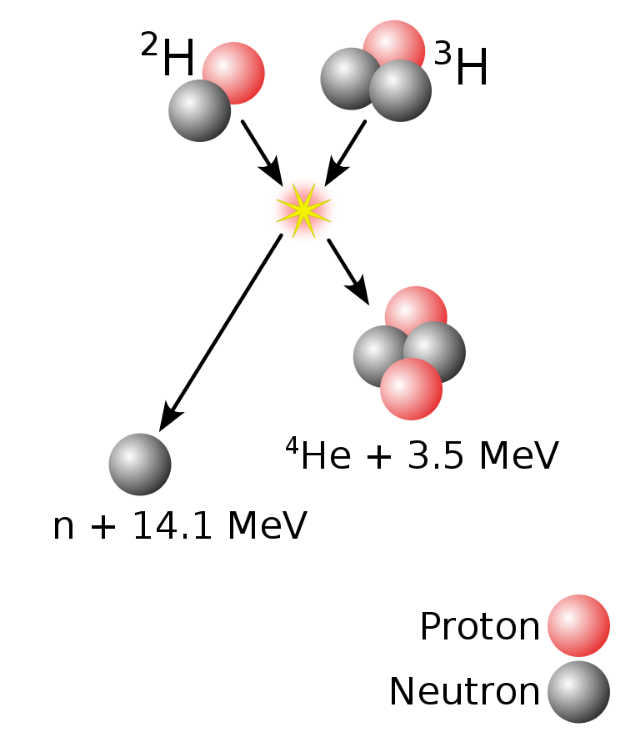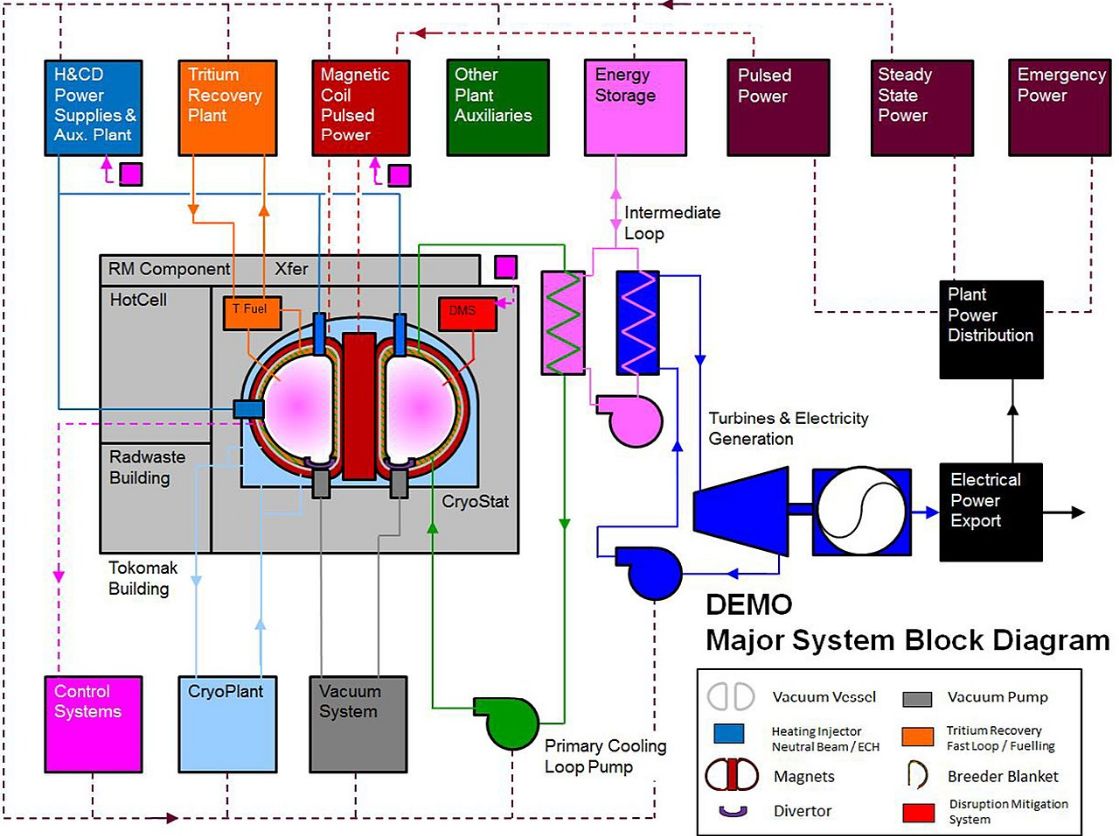DEMO (DEMOnstration Power Station) is a proposed nuclear fusion power station that is intended to build upon the ITER experimental nuclear fusion reactor. The objectives of DEMO are usually understood to lie somewhere between those of ITER and a "first of a kind" commercial station, sometimes referred to as PROTO. While there is no clear international consensus on exact parameters or scope, the following parameters are often used as a baseline for design studies: DEMO should produce at least 2 gigawatts of fusion power on a continuous basis, and it should produce 25 times as much power as required for breakeven. DEMO's design of 2 to 4 gigawatts of thermal output will be on the scale of a modern electric power station. To achieve its goals, DEMO must have linear dimensions about 15% larger than ITER, and a plasma density about 30% greater than ITER. As a prototype commercial fusion reactor, it was estimated in 2006, that DEMO could make fusion energy available by 2033, but has now been delayed. It is estimated that subsequent commercial fusion reactors could be built for about a quarter of the cost of DEMO.
- nuclear fusion
- plasma density
- fusion power
1. DEMO's Place in the Development of Fusion Power
For some ITER consortium countries, DEMO may now be a phase rather than a specific ITER consortium machine and may even see the collapsing of the DEMO and PROTO phases into one. The 2019 US National Academies of Sciences, Engineering, and Medicine 'Final report of the committee on a Strategic Plan for U. S. Burning Plasma Research' noted, "a large DEMO device no longer appears to be the best long-term goal for the U.S. program. Instead, science and technology innovations and the growing interest and potential for private-sector ventures to advance fusion energy concepts and technologies suggest that smaller, more compact facilities would better attract industrial participation and shorten the time and lower the cost of the development path to commercial fusion energy".[1] Approximately two dozen private-sector companies are now aiming to develop their own fusion reactors within the DEMO roadmap timetable.[2][3] The 3 October 2019 UK Atomic Energy announcement of a 'Spherical Tokamak for Energy Production' (STEP)[4] grid-connected reactor for 2040 suggests a combined DEMO/PROTO phase machine apparently to be designed to leapfrog the ITER timetable.[5] China's proposed CFETR machine, a grid-connected gigawatt-generating reactor, overlaps the DEMO timetable.[6][7]
2. Timeline
The following timetable was presented at the IAEA Fusion Energy Conference in 2004 by Christopher Llewellyn Smith:[8]
- Conceptual design was completed in 2017
- Engineering design is to be complete by 2024 (after input from ITER D-T tests, and data from IFMIF - both delayed (As of 2016))
- The first construction phase is to last from 2024 to 2033
- The first phase of operation is to last from 2033 to 2038
- The station is then to be expanded and updated (e.g. with phase 2 blanket design)
- The second phase of operation is to start in 2040
In 2012 European Fusion Development Agreement (EFDA) presented a roadmap to fusion power with a plan showing the dependencies of DEMO activities on ITER and IFMIF.[9]
- Conceptual design to be complete in 2020[9]:63
- Engineering design complete, and decision to build, in 2030
- Construction from 2031 to 2043
- Operation from 2044, Electricity generation demonstration 2048
This 2012 roadmap was intended to be updated in 2015 and 2019.[9]:49 The EFDA was superseded by EUROfusion in 2013. The roadmap was subsequently updated in 2018.[10]
3. Technical Considerations


When deuterium and tritium fuse, the two nuclei come together to form a resonant state which splits to form in turn a helium nucleus (an alpha particle) and a high-energy neutron.
- 21H + 31H → 42He + 10n + 17.6 MeV
DEMO will be constructed once designs which solve the many problems of current fusion reactors are engineered. These problems include: containing the plasma fuel at high temperatures, maintaining a great enough density of reacting ions, and capturing high-energy neutrons from the reaction without melting the walls of the reactor.
- The activation energy for fusion is very large because the protons in each nucleus strongly repel one another; they are both positively charged. In order to fuse, the nuclei must be within 1 femtometre (1 × 10−15 metres) of each other, where quantum-tunnelling effects permit the parent nuclei to fuse together into the resonant state. The principal is to form a quasi-Maxwellian distribution for the deuterons and the tritons, at very high temperatures, where the nuclei in the tail of the Maxwellian undergo fusion, while the continuous elastic collisions among the other nuclei will not alter the state of the plasma.
- DEMO, a Tokamak reactor, requires both dense plasma and high temperatures for the fusion reaction to be sustained.
- High temperatures give the nuclei enough energy to overcome their electrostatic repulsion. This requires temperatures in the region of 100,000,000 °C, and is achieved using energy from various sources, including Ohmic heating (from electric currents induced in the plasma), microwaves, ion beams, or neutral beam injection.
- Containment vessels melt at these temperatures, so the plasma is to be kept away from the walls using magnetic confinement.
Once fusion has begun, high-energy neutrons at about 160,000,000,000 kelvins will flood out of the plasma along with X-rays, neither being affected by the strong magnetic fields. Since neutrons receive the majority of the energy from the fusion, they will be the reactor's main source of thermal energy output. The ultra-hot helium product at roughly 40,000,000,000 kelvins will remain behind (temporarily) to heat the plasma, and must make up for all the loss mechanisms (mostly bremsstrahlung X-rays from electron deceleration) which tend to cool the plasma rather quickly.
- The Tokamak containment vessel will have a lining composed of ceramic or composite tiles containing tubes in which warm liquid lithium metal will flow, cooling the lining.
- Lithium readily absorbs high-speed neutrons to form helium and tritium, becoming hot in the process.
- This increase in temperature is passed on to another (intermediate) coolant, possibly (pressurized) liquid water in a sealed, pressurized pipe.
- Heat from the intermediate coolant will be used to boil water in a heat exchanger.
- Steam from the heat exchanger will be used to drive turbines and generators, to create electric current.
- Waste heat energy in excess of the generated electrical energy is dumped into the environment.
- Helium byproduct is the "ash" of this fusion, and will not be allowed to accumulate too much in the plasma.
- Carefully measured amounts of deuterium and tritium are added back into the plasma and heated.
- The lithium is processed to remove the helium and tritium, with the balance recycled to collect more heat and neutrons. Only a tiny amount of lithium is consumed.
The DEMO project is planned to build upon and improve the concepts of ITER. Since it is only proposed at this time, many of the details, including heating methods and the method for the capture of high-energy neutrons, are still undetermined.
4. Conceptual Design
All aspects of DEMO were discussed in detail in a 2009 document by the Euratom-UKAEA Fusion Association.[11] Four conceptual designs PPCS A,B,C,D were studied. Challenges identified included:[11]
- structural materials resistant to the high neutron flux
- high-temperature superconductors, to avoid the need for large amounts of helium for cooling, that would challenge world helium reserves
- need for high efficiency in the heating and current drive systems.
In the 2012 timeline the conceptual design should be completed in 2020.
5. Radioactive Waste
While fusion reactors like ITER and DEMO will produce neither transuranic nor fission product wastes, which together make up the bulk of the nuclear wastes produced by fission reactors, some of the components of the ITER and DEMO reactors will become radioactive due to neutrons impinging upon them. It is hoped that plasma facing materials will be developed so that wastes produced in this way will have much shorter half lives than the waste from fission reactors, with wastes remaining harmful for less than one century. Development of these materials is the prime purpose of the International Fusion Materials Irradiation Facility. The process of manufacturing tritium currently produces long-lived waste, but both ITER and DEMO will produce their own tritium, dispensing with the fission reactor currently used for this purpose.[12]
6. PROTO
PROTO is a proposal for a beyond-DEMO experiment, part of European Commission long-term strategy for research of fusion energy. PROTO would act as a prototype power station, taking in any remaining technology refinements, and demonstrating electricity generation on a commercial basis. It is only expected after DEMO, beyond 2050, and may or may not be a second part of DEMO/PROTO experiment.[13]
The content is sourced from: https://handwiki.org/wiki/Physics:DEMOnstration_Power_Station
References
- National Academies of Sciences, Engineering, and Medicine (U.S.). Committee on a Strategic Plan for U.S. Burning Plasma Research. National Academies of Sciences, Engineering, and Medicine (U.S.). Board on Physics and Astronomy. National Academies of Sciences, Engineering, and Medicine (U.S.). Division on Engineering and Physical Sciences. (2019). Final report of the Committee on a Strategic Plan for U. S. Burning Plasma Research. The National Academies Press: The National Academies Press. pp. 12. ISBN 978-0-309-48743-6. OCLC 1107989881. http://www.worldcat.org/oclc/1107989881
- Asmundsson, Jon; Wade, Will (28 September 2019). "Nuclear Fusion Could Rescue the Planet From Climate Catastrophe". https://www.bloomberg.com/news/features/2019-09-28/startups-take-aim-at-nuclear-fusion-energy-s-biggest-challenge.
- Michaels, Daniel (2020-02-06). "Fusion Startups Step in to Realize Decades-Old Clean Power Dream" (in en-US). The Wall Street Journal. ISSN 0099-9660. https://www.wsj.com/articles/fusion-startups-step-in-to-realize-decades-old-clean-power-dream-11581001383.
- Holloway, Nick (2019-10-03). "UK to take a big 'STEP' to fusion electricity" (in en-GB). https://ccfe.ukaea.uk/uk-to-take-a-big-step-to-fusion-electricity/.
- Gibney, Elizabeth (2019-10-11). "UK hatches plan to build world's first fusion power plant" (in en). Nature: d41586–019–03039-9. doi:10.1038/d41586-019-03039-9. ISSN 0028-0836. http://www.nature.com/articles/d41586-019-03039-9.
- Liu, Xiaogang; Wang, Zhaoliang; Ren, Yong; Li, Junjun; Yin, Dapeng; Li, Lei; Gao, Xiang; Wu, Yu (2018-01-01). "Mechanical performance evaluation of the CFETR central solenoid model coil design". Nuclear Fusion 58 (1): 016035. doi:10.1088/1741-4326/aa9866. ISSN 0029-5515. Bibcode: 2018NucFu..58a6035L. http://stacks.iop.org/0029-5515/58/i=1/a=016035?key=crossref.4309661f87883f6f311d28b2f2f8f627.
- Li, Jiangang (11-14 May 2015). "Closing gaps to CFETR Readiness". IAEA TCM 3rd DEMO workshop, Hefei, China: Institute of Plasma Physics, CAS. http://www-naweb.iaea.org/napc/physics/meetings/TM49530/website/talks/May%2012%20Sessions/Li_J.pdf. Retrieved 30 May 2018.
- "Beyond ITER". Information Services, Princeton Plasma Physics Laboratory. Archived from the original on 7 November 2006. https://web.archive.org/web/20061107220145/http://www.iter.org/Future-beyond.htm.
- Fusion Electricity - A roadmap to the realisation of fusion energy EFDA 2012 - 8 missions, ITER, DEMO, project plan with dependencies, ... https://www.euro-fusion.org/wpcms/wp-content/uploads/2013/01/JG12.356-web.pdf
- EUROfusion. "Roadmap" (in en). https://www.euro-fusion.org/eurofusion/roadmap/.
- DEMO and the Route to Fusion Power, Derek Stork, Euratom-UKAEA Fusion Association, September 2009 http://fire.pppl.gov/eu_demo_Stork_FZK%20.pdf
- "ITER-Fuelling the Fusion Reaction". International Thermonuclear Experimental Reactor. http://www.iter.org/sci/fusionfuels. Retrieved 2010-07-28.
- The roadmap to magnetic confinement fusion, Damian Hampshire 2008 - Says ITER and IFMIF will be completed in 2016 https://community.dur.ac.uk/superconductivity.durham/The%20roadmap%20to%20magnetic%20confinement.pdf
